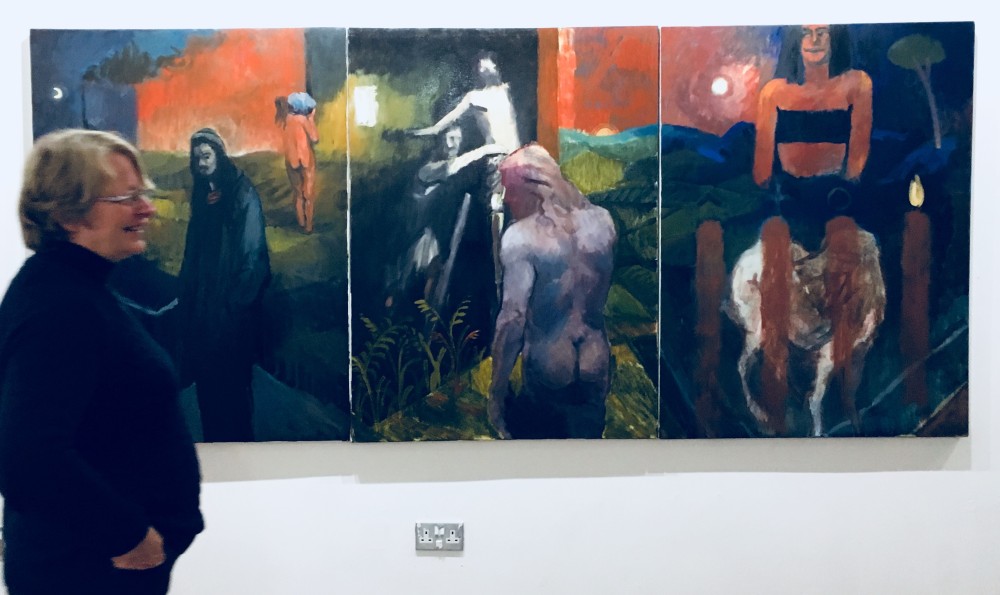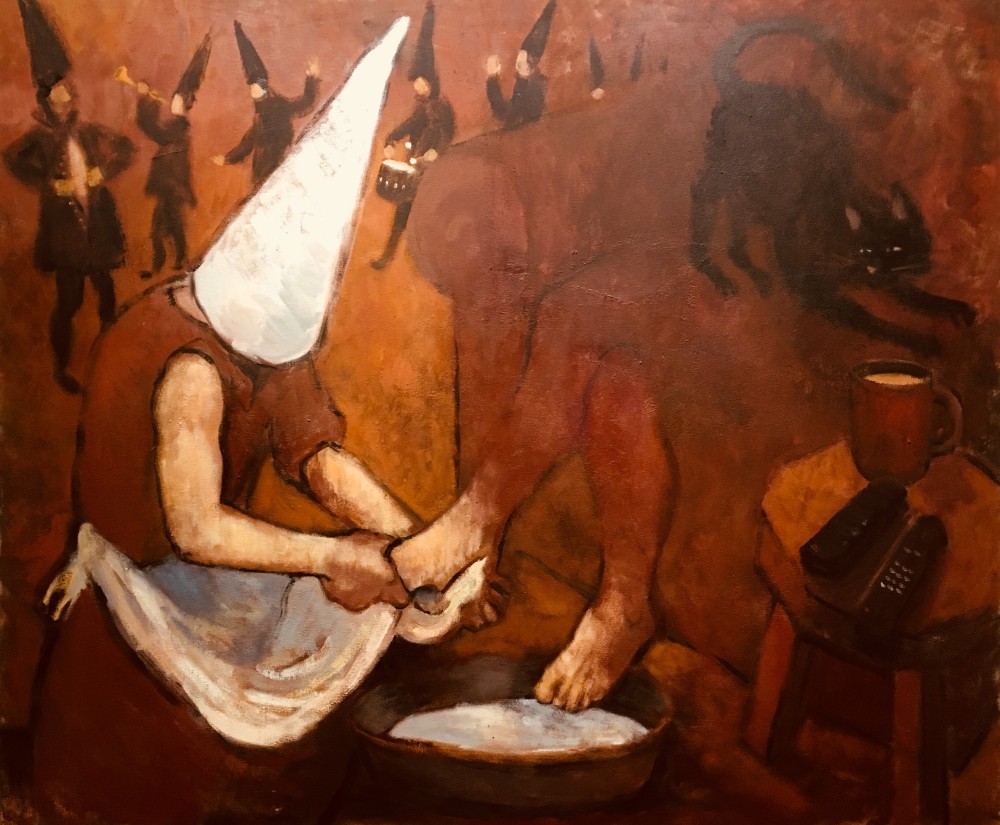
Many of the figures in Michael Chance’s recent show have a stuttering, hesitant quality. Painted with harsh square strokes and often thickly outlined, they are not relaxed in or fully inhabiting their bodies, but instead oddly tensed, or perhaps captured creaking in transit. The elongated, crumpling legs of the figure in ‘Pity’ are caught in a moment between standing and collapse. With its flatfootedness, shortened stride, and hunched shoulders, the figure in ‘Please Take Me Back’ appears pitiably geriatric, its limbs momentarily locked as a hand gropes for a nearby railing.
Therein lies a marked difference between the bodies of men and those of women as painted by Chance in his ominously titled show The Ruin of Man: male bodies seem comprised of rigid pieces, sometimes barely being held together, whereas female bodies have a sense of wholeness and vitality, as exemplified by the stretching, curved figure in ‘She Woke’.

Elsewhere, a complimentary dynamic is illustrated in ‘Nudes from Nowhere’: the male figure sits, hunched into a ball with its back to us, head bowed as if acquiescing to the portent of mankind’s ruin. To its right, a voluptuous female figure dances, rendered in vibrant red as if to conjure Matisse’s dancers. This image offers an easy introduction to Chance’s commentary on the downfall of dominant masculinity, wherein our attention is not drawn to a hackneyed idealisation of ‘the feminine form’ but instead to the relative decline and irrelevance of the male.
In the context of the often elliptical and obfuscating titles attached to many similar shows, it’s surprising how all the paintings in The Ruin of Man relate directly to the evidence for, and permutations of, such a declaration of doom. We have scenes of emotional devastation, such as the anguished facial close-up of ‘Exit’; a depiction of bodily decrepitude in the aforementioned ‘Please Take Me Back’; and a suggestion of ecological disaster in ‘Venus, or Mars?’, a vision of the iconic armless sculpture against a scorched landscape billowing with distant smoke, its head blackened. Something has gone terribly wrong with the way in which mankind is living and this manifests in a breakdown of relationships: with our bodies, with each other, and with nature.

The differing presentations of male and female bodies here adds a more hopeful aspect to this show and goes some way to tempering all this Anthropocene angst. The small square canvas ‘Ushering Out the Old’, the image with which this show has been advertised, makes literal what was suggested by the contrasting figures in ‘Nudes from Nowhere’. With a gesture that is tender yet decisive, a female figure rests her hand on a shoulder to guide away a male figure made representative of wider masculinity by his white shirt and bald pate. Her presence as a female nude initially seems to jar with the message here but is possibly best interpreted as an advocacy for averting the male gaze, given that she is turning the male figure away. In this respect, we can also consider the ‘old’ in art historical terms, bound up with who is given licence to look.

This ushering of an era to its end is clearly something in which Chance is personally invested. He reflects upon his own complicity as a young white man and perhaps his unsuitably to see this story through, painting himself into the left panel of the Blake-inspired, revealingly titled ‘Transition’ triptych as if already prepared to step aside.
In his detailed notes for the show, presented in a small accompanying book, he elaborates upon the links in his work between toxic masculinity and the toxification of the natural environment, indicting unchecked male power for tainting everything it touches. He argues against what he claims is a spurious duality, perpetuated by centuries of patriarchy, between humanity and ‘nature’ (here specified as the local and global ecology). His proposed corrective is nothing new: a renewed focus on empathetic understanding figured in similar terms to the notion of ‘fellow feeling’ put forward by such Victorian social problem novelists as George Eliot. There exists in Chance’s writing a disconcerting equation of such ‘feeling’ with femininity, thereby reinforcing one long-standing binary in the course of attempting to defeat another. His thoughts on the positive alternative presented by traditions of eastern mysticism also lack any reflection upon his limited qualifications to make such wide-ranging (and outdated) assumptions.

Chance is evidently still grappling with his own place in this debate, compelled to speak out but thwarted by the knowledge that his voice is not necessarily the one that needs to be heard right now. The most accomplished piece here chooses to approach the show’s themes in stranger, dreamier terms. His ‘Penitent’ (pictured directly above) is a tribute to Degas mixed with a personal memory of washing his mother’s feet in the family’s living room. The rich earthy hues, against glowing fleshtones and strokes of brilliant white, situate the scene simultaneously in a painterly parallel universe and in the ‘groundedness’ of domestic life, the latter exemplified by the poised cat, mug of tea and television remotes. The whole effect is intimate, macabre, and humourous, given an added sense of playful spectacle by the kneeling figure’s conical headgear – conjuring both Ken Russell’s The Devils and the Silent Hill video games – and the parade of similarly attired musicians heralding his act of devotion. The complex interrelations of these elements suggest a fruitful direction for a painter very much searching for his own place amidst the ruins. Ω